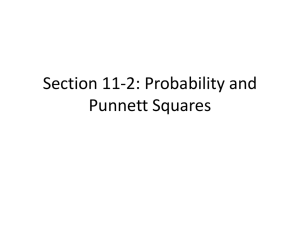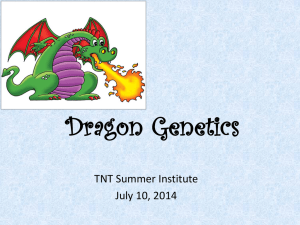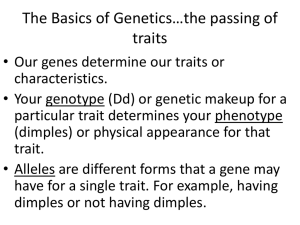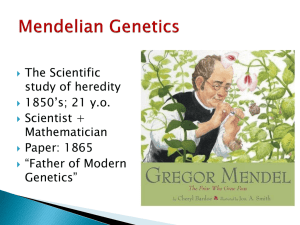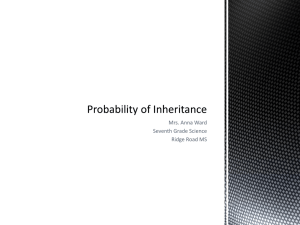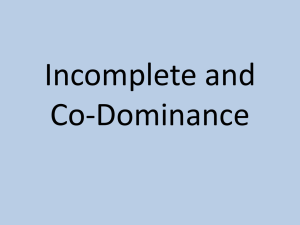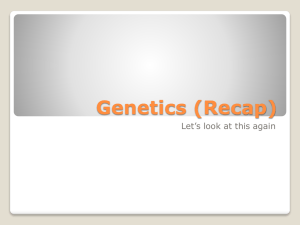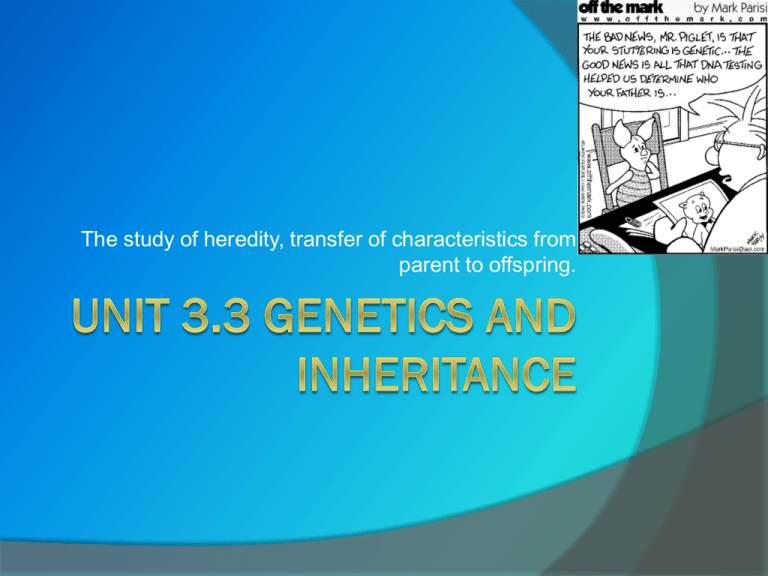
The study of heredity, transfer of characteristics from
parent to offspring.
A. The Father of Genetics:
Gregor Mendel is known as the Father of Genetics.
He studied pea plants, because they were easy to
observe and reproduce.
Knowing that the male part of the plant produced
sperm, and that the female part produced the egg,
he was able to join the two reproductive cells. This is
called fertilization.
B. Inheritance of chromosomes
Egg + sperm
(meiosis)
(fertilization)
zygote (earliest stage of development)
(mitosis and development)
fertilization
zygote
egg
meiosis
mitosis &
development
sperm
B. Inheritance of Chromosomes
Chromosomes exist in pairs, one
from sperm and one from egg.
Known as homologous pairs
A section of DNA within the
chromosome that contains the info
to make proteins called a gene.
Genes determine our traits.
A trait is any physical or
physiological characteristics.
Ex: eye color, blood type
We will all receive the same type of
genes but we can get different
versions of a gene called an Allele.
Ex: Gene: thumb type.
Alleles: Hitchhikers thumb or
straight thumb.
Alleles are represented by letters. A
dominant allele is written with a
capital. A recessive allele is written
with a lowercase.
Ex: Hitchhikers thumb (A) or
straight thumb (a).
*Dominant genes masks/hides
recessive.
Genotype describes the 2 alleles you received
from mom and dad.
Homozygous means you received identical
copies (purebred)
AA – homozygous dominant
aa - homozygous recessive
Heterozygous means you got one dominant
and one recessive (hybrid); Aa.
○ 2 people can have the same
appearance but have different
genetics: AA vs Aa.
Phenotype describes how the alleles are
portrayed or look physically.
Warm-up Oct. 17th #33
Allele
For any trait, such as hair
color, there are different
forms of the protein that
create the different hair
colors. Each different
form is called an allele.
We use capital letters
to represent dominant
alleles and lower case
letters to represent the
recessive alleles.
Genotype
vs.
Phenotype
Genotype is the genetic
makeup (AA, Aa, or aa)
Phenotype is the
physical trait, a result of
the genotype
From gene to protein
protein
transcription
translation
Warm-up Oct. 18th
Mendel’s
Principles of
Inheritance:
Principle of:
Dominance
Segregation
Independent
assortment
#34
GENOTYPES
Homozygous
Dominant= BB
Heterozygous= Bb
Homozygous
recessive= bb
D. Mendel’s Three Principles
1. Principle of Dominance: dominant alleles
can mask/ hide recessive alleles
Genotypes:
Phenotypes:
Homozygous dominant:(AA) Dominant trait is expressed
Heterozygous: (Aa)
Dominant trait is expressed
Homozygous recessive:(aa) Recessive trait is expressed
D. Mendel’s Principles
2. Principle of Segregation: during meiosis the
alleles separate so each parent can only pass on
one allele per trait. We get half of our genes from
each parent.
D. Mendel’s Principles
3. Principle of
Independent
Assortment: genes
on separate
chromosomes are
passed on
independently
(randomly) from one
another.
E. Genetic Probability
Punnett squares are used to predict
the outcome of fertilization between the
gametes.
The sides of the Punnett square are labeled
with the genotype from each parent (sperm
and egg).
Monohybrid Cross- involves only
1 trait.
Dihybrid Cross- involves 2 traits.
Mendelian Genetics
•
•
What is the phenotypic ratio (compare
the result of the genes)?
What is the genotypic ratio (compare
the genetic combinations)?
Father
?
?
Ex: Huntington’s disease breaks down
the nervous system. It is a dominant
trait. If a heterozygous woman marries
a man without Huntington's what is
the chance their kids will have the
disease? _______%
Mother
H
h
Genetics Group Practice10 punnett squares
Draw a card from the gene stack and one
from the parent stack- WRITE THIS DOWN
before working the problem
Complete the cross by doing a punnett
square (alleles are already assigned, see
your instruction sheet)
Complete the Genotype and phenotype
ratios
Write what the children will look like:
25% blond hair
75% brown hair
Ticket Out the Door
Cross a heterozygous man who has
dimples with a woman who has no
dimples.
Set up alleles (letters)
Work punnett square
Genotype ratio:
Phenotype ratio:
What are the chances of their child
having dimples?
Mendel Song
http://www.youtube.com/watch?v=mx6m
aAOOfxQ
October 19th Warm-Up # 35
Trait:
Free earlobes- dominant =
F
Attached earlobes- recessive =f
1. A woman has free earlobes, what are two
possible genotypes she might have?
2. The genotype for a man is Ff, what is his
phenotype?
3. What is a gene?
5 types Non-Mendelian Inheritance
These traits are NOT just dominant or recessive, there for they
do not follow the Mendelian genetics.
1. Codominance: Both alleles are equally dominant and
will be expressed (in heterozygote).
o Phenotype: both versions of the trait show in the
heterozygote
o Genotype: use 2 different letters.
o Ex: Sickle Cell Anemia is a codominant disorder.
This means that you will have normal disk shaped
cells (N), and sickle shaped cells (S).
o
3 Possibilities:
Genotype
Phenotype
NN
Normal cells only
NS
Normal & Sickle cells
SS
Sickle cells only
* Heterozygous genotype is resistant to malaria.*
Codominant Example:
Cross a black cow with a white cow.
Both hair colors are dominant.
2. Incomplete Dominance- neither allele is completely
dominant to mask the other.
○ Phenotype: the heterozygote results in a blended
phenotype.
○ Genotype: Capital letters for both alleles and use a prime
(‘) symbol.
○ Ex: In humans this happens in the genes for curly hair.
H= curly, H’= straight. So…
Genotype
Phenotype
HH
Curly
H H’
Wavy
H’ H’
Straight
Incomplete Dominance Example
Cross a white flowered plant with a pink
flower. Both white and red are
incompletely dominant.
Warm-up Oct. 22nd #36
Codominant
If two alleles are
codominant, they
are equally strong.
Both alleles would
be seen in the
phenotype. An
example is crossing
a black chicken with
a white chicken and
the offspring having
both black and
white feathers.
Incompletely
Dominant
Neither allele is
dominant, so when
both alleles are
present they mix or
blend. These alleles
are written with ONE
letter that has a
prime ‘
Non Mendelian Genetics:
Codominance:
Both alleles are
equally dominant
and will be
expressed
Phenotype:
3 possibilities
Genotype:
2 Capital letters;
BB, WW, or BW
Red hair is
dominant
RR
Roan is a
mixture of
red and
white hairRW
White hair
is
dominant
WW
Incomplete Dominance
Phenotype: neither allele is completely
dominant to mask the other
Genotype: heterozygous RR’ results in
a blended phenotype , capital letters for
both traits and use a prime ‘ symbol for
one
RR
RR’
R’R’
3. Multiple Alleles: more than two alleles
exist for a trait
Blood Types: A, AB, B, O
Genotype
Phenotype
IAIA
A
or IAi
AB
IAIB
IBIB
or
IBi
(ii)- recessive
B
O
Blood Type Example
Cross a heterozygous type A mom with
a Type O dad. What is the chance they
have a child with Type O blood?
4. Sex-linked Traits:
Are you colorblind??
4. Sex-Linked: trait found on the X sex chromosome.
Hemophilia and Color blindness are recessive disorders.
Phenotype:
Female – less likely but can express a
sex-linked trait
Male –express sex-linked traits more
often because they have only one X
sex chromosomes
Female
Male
Genotype
Phenotype
Genotype
Phenotype
XA XA
Unaffected
XA Y
Affected
XA Xa
Carrier
No male-carriers for a sex
linked disorders.
XaXa
Affected
XaY
Unaffected
Sex-linked Example
Cross a colorblind dad with a mom who
is a carrier. What is the chance of this
couple having a son who is not
colorblind?
5. Polygenetic- Traits that depend on many genes
and create a range of phenotypes.
NO PUNNETT SQUARE can be used.
Instead these traits can be graphed using a bell-shaped
curve. There is a wide range of differences.
Ex. Height, skin color, weight
Warm-up
th
#37
Oct.25
Sex
chromosomes
For humans, the last set of
chromosomes are the sex
chromosomes that
determine the gender.
Females have two X
chromosomes and males
have one X and one Y.
Examples of sex-linked traits
are colorblindness and
hemophilia, these traits are
carried on the X
chromosome.
Polygenic
trait
trait determined by many
genes, results in a wide
range of phenotypes
Examples include height,
skin color, hair color
Warm-up #38 October
1.
th
26
What is a genetic disease?
Write down your thoughts
2.
From the diseases listed below,. Make three columns on
your paper and place each into either the genetic,
environmental, or infectious disease column.
Cancer
heart disease
Color-blindness
Down’s syndrome Malaria
Sickle Cell Anemia
Stroke
Flu
Strep Throat
Cystic Fibrosis
Hemophilia
Klinefelters
Type II Diabetes
Muscular Dystrophy High Blood pressure
Lyme disease
HIV
Common Cold
Warm-up #39 Oct. 30th
1. Achondroplasia is a
form of dwarfism
inherited as a
completely dominant
trait. Two
achondroplastic
dwarfs have a dwarf
child; later, they have
a second child who is
normal.
What are the chances
of their third child
having
achondroplasia?
2. Barbara, who is not colorblind, and her
husband Bill had a colorblind baby girl.
Which statement about this situation is
true?
FIRST DETERMINE WHAT THE
GENOTYPES OF THE PARENTs WOULD BE!
a. Barbara’s father must have been
colorblind
b. Barbara’s mother must have been
colorblind
c. Bill’s mother must have been colorblind
d. Bill must be colorblind
Warm-up Oct. 31st
#40
Gene Disorders vs. chromosomal disorders
Gene disorders: Diseases inherited as a single
gene on a single chromosome
Arise from mutations on within a single gene
Chromosomes disorder: caused by receiving
a missing or extra chromosome--- like Down
Syndrome
Often caused by NONDISJUNCTION during Meiosis
Called ANEUPLOIDY
Can be detected on a KARYOTYPE: a picture of the
chromosomes
Peer Assessment
Use your rubric to give each group a
score for each category (1-4)
Add up all the scores for a total
BE HONEST!!
Warm-up Nov. 1st #41
Autosomal
Aneuploidy
Having too many or too few
chromosomes
Caused by mistakes in
Meiosis--nondisjunctionhomologous pairs do not
separate during meiosis
Example:
DOWN’s SYNDROME
Trait
Trait inherited on
one of the first 22
pairs of
chromosomes…
….
NOT sex-linked
What environmental and lifestyle factors
determine human characteristics?
Environmental factors include things like lack
of access to clean water, living in an area with
air pollution, or living in a densely-populated
area with little or no sanitation. Lifestyle factors
are the choices people make that impact their
health. They include things like smoking,
drinking, doing drugs, or eating unhealthy
foods. People who have healthy lifestyles and
live in unpolluted environments are more likely
to be healthy and free of disease than people
who have unhealthy lifestyles or who are
exposed to lots of pollution.
Do genes or the environment
influence your traits?
Use examples from this activity to
defend your view point.
EXPLAIN the evidence.
H. Genetic Disorders
1.
Huntington’s disease- found on
chromosome 4, causes brain to
break down, loss of muscle
coordination, and symptoms often
appear in your 40’s.
2.
Pattern of Inheritance: Autosomal
Dominant
Sickle-cell Anemia- leads to
misshapen red blood cells, leads
to poor circulation and pain.
Pattern of Inheritance: Autosomal
Codominant (both versions of trait are
equally dominant)
Heterozygous individuals are resistant
to malaria
Primarily in African-Americans
3. Cystic fibrosis- increased mucus in lungs and
digestive tract,.
Pattern of Inheritance: Autosomal Recessive
Mostly affects Caucasians.
4. Tay-Sach’s disease- breaks down central
nervous system leading to premature death
(die before 2).
Pattern of Inheritance: Autosomal Recessive
Found in Jewish and Pennsylvania Dutch populations.
5. PKU (phenylketonuria)- Inability to break down
the amino acid phenylalanine,
Can build up in brain and lead to decreased
mental function
Pattern of Inheritance: Autosomal
Recessive
Can be controlled by diet
6. Hemophilia- blood does not clot
normally
Pattern of Inheritance: Recessive
sex-linked disorder
Mainly affects males. Carriers are
females only.
7. Colorblindness
Pattern of Inheritance: Recessive
sex-linked disorder
Mainly affects males. Female
carriers only.
I. Chromosomal Disorders
Inherited due to problems with the
ENTIRE chromosome.
Caused by a mistake in MEIOSIS
called nondisjunction.
Nondisjunction is when
chromosomes fail to separate
properly. This mistake leads to
Aneuploidy- an incorrect (extra or
missing) number of chromosomes
in a fertilized zygote.
Non disjunction causes aneuploidy
1. Down’s Syndrome- is caused
by an extra chromosome #21
(trisomy 21). Causes mental
retardation, heart defects, and
an enlarged tongue.
2. Klinefelter’s Syndrome- male has an
extra X-chromosome (XXY).
Male but develops female
secondary sex characteristics, and
usually sterile.
Use testosterone therapy to treat.
3. Turner’s Syndrome- female with
ONLY one X-chromosome (XO).
Female with underdeveloped
gonads, infertile.
J. Nature vs. Nurture:
Nature is heredity (your DNA).
Nurture is your environment
Scientist debate: Which has a greater influence?
Example: We use identical twins to study the effects of the
environment on genes.
Diet: can stop the progression of PKU, and limit the risk for
genetic predispositions such as diabetes, heart disease, and
certain cancers.
Environmental Toxins: environmental factors such as UV
radiation or tobacco can directly change our genes (lung/mouth
cancer, skin cancer)

